|
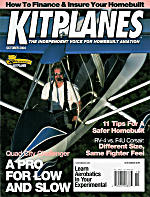 Quad
City's Challenger Quad
City's Challenger
For 21 Years The
"Unchallenged Leader"

Kitplanes Magazine
October 2004

Quad City Challenger
"A PRO FOR LOW AND
SLOW"
Written By Dan Johnson
For 27 years Dan Johnson has been writing
for a veritable Who's Who of aviation magazines. He has produced two books
and a video on flight testing. He has been honored as the recipient of
the Moody Award from the United States Ultralight Association, the Spirit
Of Flight Award from the Society of Experimental Test Pilots, and the Outstanding
Leadership Award from ASTM International. Dan now leads the EAA Sport Pilot
/ Light Sport Aircraft initiative.
(PHOTOS BY
RICHARD VANDER MEULEN AND DAN JOHNSON) 
|

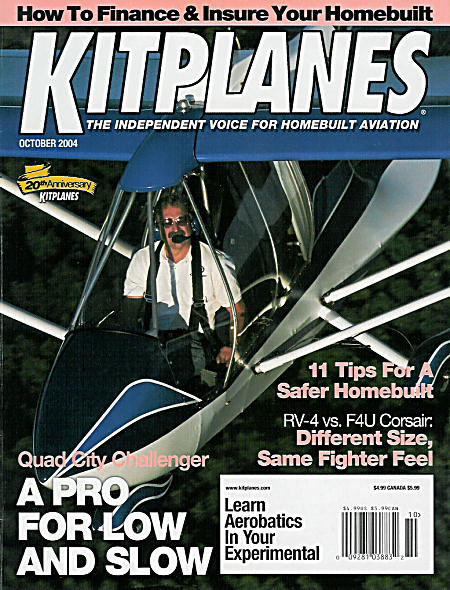
"Quad City Ultralight Aircraft has delivered
more than 3,000 Challengers!"

|

For 21 Years, Quad City's Challenger
has proved a good choice,
by Dan Johnson
It's enough to create a serious case of envy among producers vying
for the market the Challenger seems to own year after year. Even in 2003,
a slow year for all aircraft manufacturers, Quad City Ultralight Aircraft
pumped out another 120 kits. Most light-sport aviation companies would
consider that an excellent performance. For Quad City, it was a down year!
The venerable company from the Quad Cities area of Illinois, near
the Iowa border, has put more than 3,000 aircraft in the air. (Ed: over
3,500 in 2008). The Challenger is clearly one of the industry's leaders!
The company has enjoyed the same management since it was founded more than
two decades ago.
Last year the company celebrated 20 years of operation and this year
Quad City reached another milestone with the 20th anniversary of the two-seaters
that have made up the majority of its production. (Ed: 25 years in 2008!)
|


"I tried to spin the Challenger after
Zank told me I wouldn't be able to do it.
For the most part he was right, though I was able to get
a modest partial spin to the right. Virtually confirming his confidence,
the Challenger flew itself out of the spin even though I tried to hold
it in."

|
The Demo Plane Duo
For this review I had a chance to fly two different two-seat Challengers.
One was built by Al Mader, a middle school art teacher in Medford, Wisconsin.
Though Mader instructs seventh and eighth grade students (a task most pilots
wouldn't dare attempt), he had never before built an aircraft. Indeed,
Quad City's fastbuild kit is one of the Challenger's strongest sales arguments.
Mader received his first taste of ultralights with Don Zank of Zanklites
in Wisconsin, who also sold him the kit. A 4,000-hour pilot in Challengers
alone, Zank is one of the most experienced U.S. dealers. Headquartered
at the Gateway airport he owns, Zank works with area pilots to whom he
sells aircraft.
And for years, Zank has been the face of Quad City at Oshkosh AirVenture.
Challengers are the backbone of his enterprise and he now runs the company's
display at the big summer event. When I flew with him, I saw a pilot in
good harmony with his flying machine and one who remains excited about
them after all those flight hours - maybe it's because of all those flight
hours.
Successful Company, Successful
Design
The truth of Quad City's success may be revealed by this grudgingly
complimentary statement by a competing manufacturer: "They [Quad City]
build a low-cost ultralight and deliver it swiftly." For more than
two decades, the company has been satisfying pilots and challenging competitors.
Quad City supplies an airworthy flying machine that brings flying
enjoyment combined with an unusual ease of building - the company does
a substantial part of the assembly, saving the builder considerable hours.
Quality and flight characteristics notwithstanding, consistently low prices
and quick shipments are a big party of Quad City's success.
To me, one of the most endearing qualities of the Challenger is its
light weight when compared to many ultralights. A two-seat Challenger with
basic but sufficient equipment tips the scales at barely more than 300
pounds empty.
As Mader came to learn from his building and flying experience, light
weight benefits handling and low-speed performance. The slower speed realm
of ultralights is an endearing capability and keeping weight low is one
of the best ways to ensure these capabilities.
But while Challengers can be light, they are also surprisingly roomy
- partly a benefit of tandem seating. If you want a plane that won't squeeze
you, here it is. Especially with doors that curve outward to add dimension,
Mader's plane was roomy. In a tandem aircraft, no one rubs elbows with
you or blocks your vision to either side.
Challengers are quite maneuverable on the ground. The turn radius
was so tight as to nearly allow a 360° turn within a wingspan. The
inside maingear wheel appeared to scribe a circle only a few feet in diameter.
Most pilots appreciate crisp taxiing, and it is certainly handy on a crowded
ramp.
|

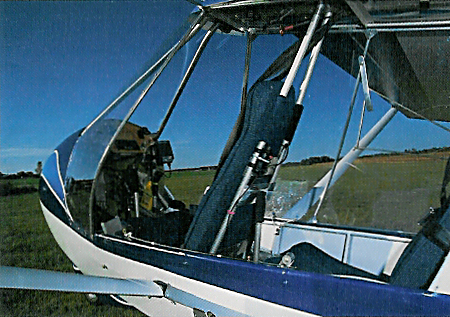
According to the author, the Challenger boasts
a surprisingly roomy cockpit,
which is due in part to the fact that the design features tandem seating.

|
In-Flight Characteristics
Having taxied to the proper end of Gateway Airport's north/south
runway, I added power. Following a brief ground roll we rotated at barely
more than 30 mph indicated and we were flying.
After a couple takeoffs and landings, I was reminded how easily the
Challenger goes into the air and just as simply returns to the runway.
Controls are cooperative and have no touchiness to them. The plane retains
energy quite well in ground effect so at excessive approach speeds you
float before getting it on terra firma.
When I later flew with Zank, he demonstrated one of the deepest,
slowest slips I have ever seen in any aircraft. It felt like we were descending
vertically, yet on releasing the controls the Challenger simply started
flying as though no changes had ever been made.
Despite their easy handling during takeoff and landing, Challengers
exhibit an odd adverse yaw quality. When sampling reaction to aileron-only
input with no rudder application, Zank's Challenger will go around an entire
circle the wrong way assuming you do not release the control input. Naturally,
you wouldn't hold the controls this way as I did, and when controlled in
a conventional manner, the Challenger shows conventional handling characteristics.
The good aspects of the Challenger's handling are many. Coordinated
control authority is strong, allowing operations even in strong crosswind
conditions. Control pressures are light, keeping pilot fatigue to a minimum.
The Challenger exhibited good response in all axes, and harmony was quite
reasonable. But you must use the controls together, just as your instructor
taught you.
It's easy to design crisp handling at higher cruise speeds, but the
Challenger particularly shines at slow-speed handling, superior to many
other designs. This low and slow flying remains the domain of ultralight
aviation and charms many pilots. The Challenger does particularly well
in this régime.
However, the low-speed capability doesn't prevent the aircraft from
offering speeds with more zip. When you push the nose over, the design
moves out smartly. In level flight at full throttle Challengers can hit
100 mph (their Vne).
The light weight of the design also helps in performance areas like
takeoff ground roll and reduced-power descendents. The idle-thrust sink
rate of a Challenger can be as low as 400 fpm, better than many ultralight
designs. Should your engine take a vacation, you'll appreciate the extra
time aloft to determine your approach.
|

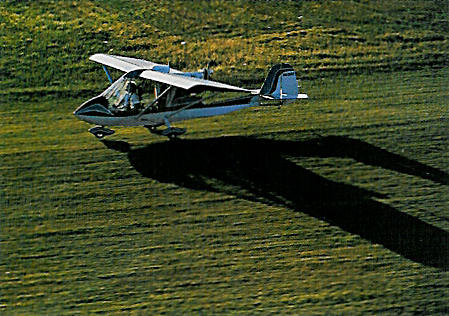
The author says after a couple takeoffs and
landings, he was reminded
how easily the Challenger goes into the air and just as simply returns
to
the runway. Controls are cooperative and have no touchiness to them.

|
Long in the Saddle
After 20 years of market success with many aircraft flying at airfields
across the country, Challengers boast an enviably good safety record. You
simply don't hear of many problems with the aircraft and it rarely shows
up in serious accident reports.
A good preliminary design with long evolution, careful quality control,
understandable builder instructions and corrections to known deficiencies
are all desirable goals of any aircraft manufacturer. However, even well-designed
aircraft can still have problems. The Challenger's low level of incidents
may say more than all the testing or any number of product evaluations.
If pilots don't often crash in a plane when measured over a long time,
most experts would agree that the engineering must be up to the task.
Lower speeds and low kinetic energy are strong attributes of ultralight
aircraft. The Challenger line, especially the longer-winged models, makes
good use of this. Since this ultralight is docile at slow speeds, I was
able to deliberately miscontrol it at speeds in the low 30s and it just
wanted to keep flying.
In more conventional verifications, I performed a longitudinal stability
series of pushing or pulling the stick and releasing. The design proved
positive in all such checks as the Challenger returns all by itself to
level flight.
I also tried stalls in all the usual configurations (power off, power
on, and accelerated). All were mild. When the wing does quit flying, the
Challenger seems to pivot at the top, lower its nose a bit and then resume
flying as if the stall never happened.
In an earlier flight test, I tried to spin the Challenger after Zank
told me I wouldn't be able to do it. For the most part he was right, though
I was able to get a modest partial spin to the right. Virtually confirming
his confidence, the Challenger flew itself out of the spin even though
I tried to hold it in.
|

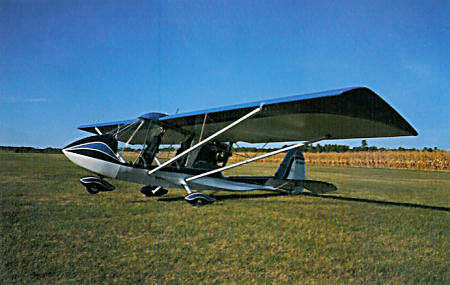
The Challenger's low level of incidents may
say more than
all the testing or any number of product evaluations.
If pilots don't often crash in a plane when measured over a long time,
most experts would agree that the engineering must be up to the task.

|
A Fair Challenge
In an age when light-sport airplane costs are zooming into the stratosphere
the Challenger remains a bargain. Even with all the factory options and
even with aftermarket extras you could afford a small fleet of Challengers
for the price of one fiberglass two-seater from Europe! Plus you can get
a Challenger relatively quickly, although deliveries do vary somewhat depending
on the time of year.
Challengers are available in four configurations: two-seater or single-seater;
long wing or clip wing. The clip wing models are also known as Challenger
Specials because they include as standard some features which are optional
on the Standard model. Note however that the Special and Standard models
when comparably equipped are comparably priced.
Zank likes to add his own selling points: "All challengers are
effectively quick-build kids. The factory handles all the more demanding
structural work, including installing the controls." Most companies
charge a considerable extra fee for their quick-build option.
"First-timers usually take less than 300 hours to complete the
assembly including covering and painting," Zank says. Once your Challenger
has been completed, it only takes a half hour or so to remove or reinstall
the wings for storage or trailing.
The price of quick-build kids for the Challenger, which include the
engine and all covering materials except paint, haven't gone up significantly
in the last decade. The reason for this may be that the design is evolving
rather than radically changing. You'll want to compare costs carefully,
as most other kit manufacturers publish price lists that exclude the engine
just as they charge a premium for quick-build versions.
For pilots on a budget, the Challenger offers a good value, no question.
The quartet of models has also satisfied a large number of customers by
providing a handling and performance package with a strong safety record.
Quad City's Challenger line represents a firmly established brand, so building
and maintaining your Challenger should be a straightforward task. It seems
as if Quad City Ultralight Aircraft has covered all the bases important
to recreational pilots.
|
![]()